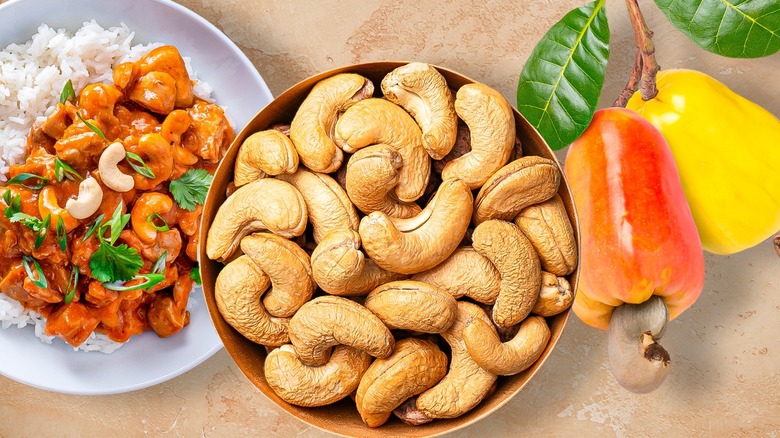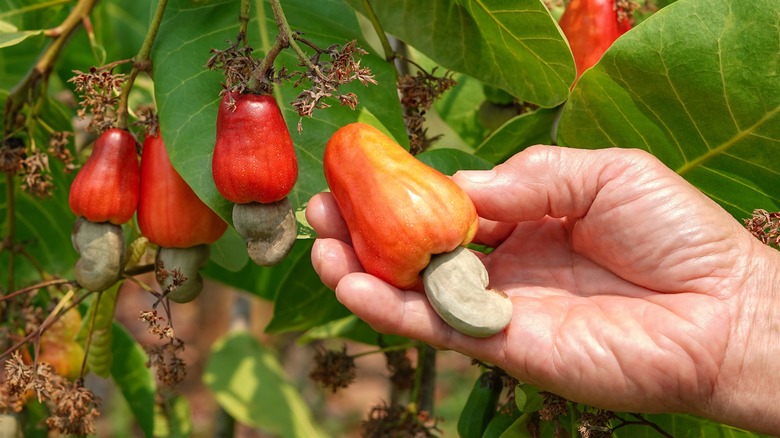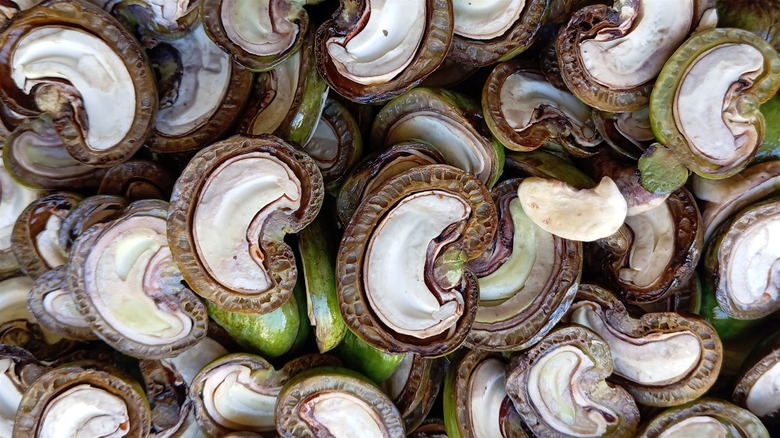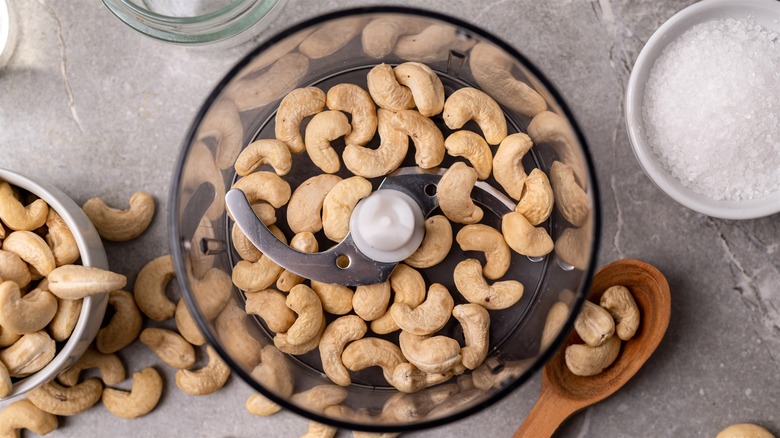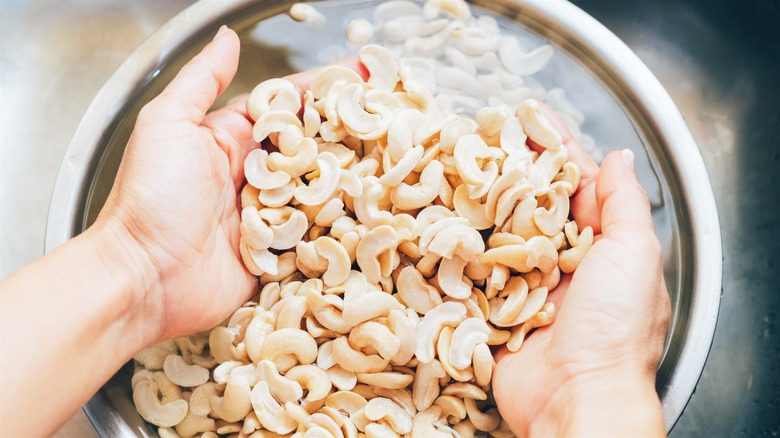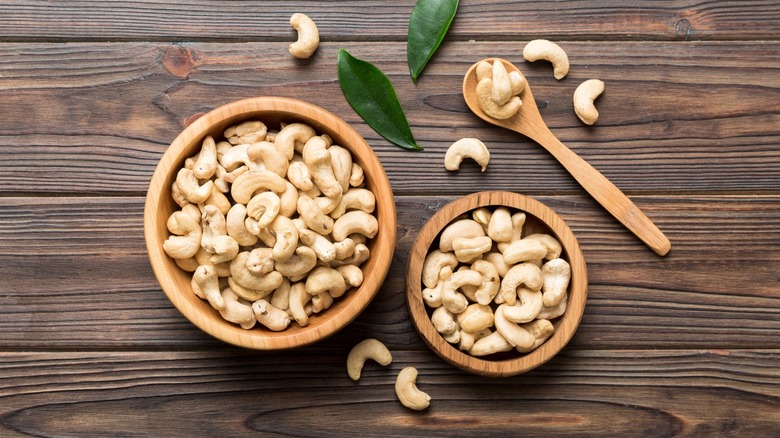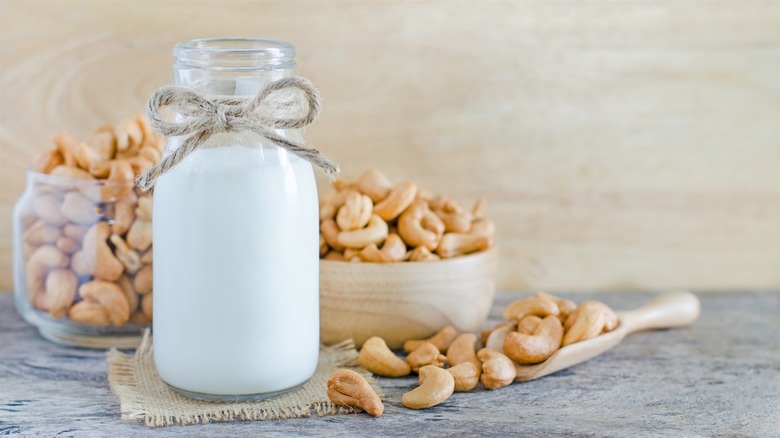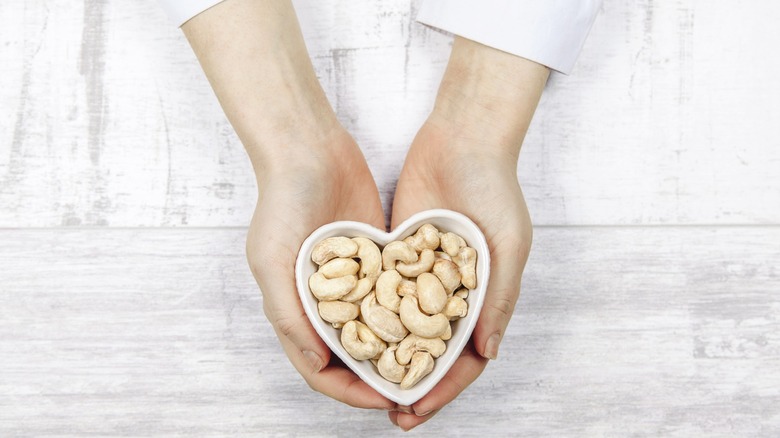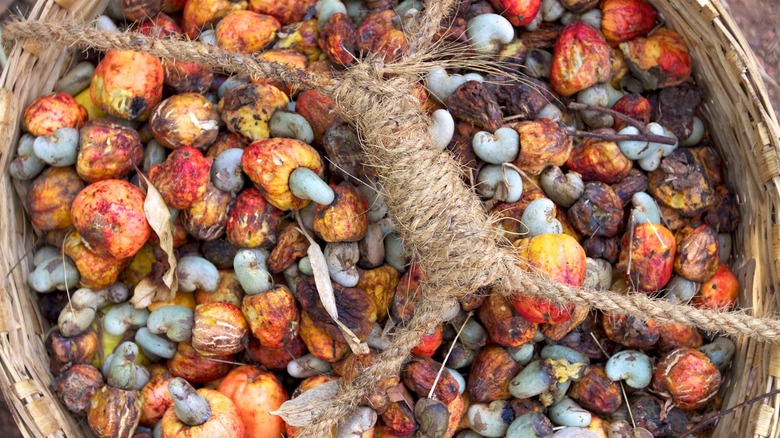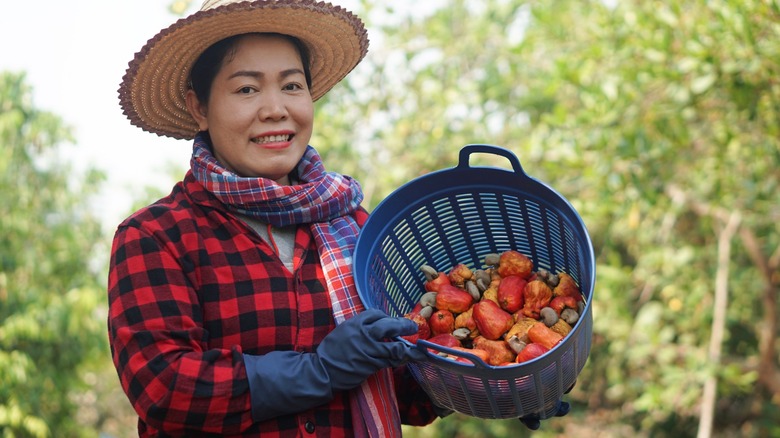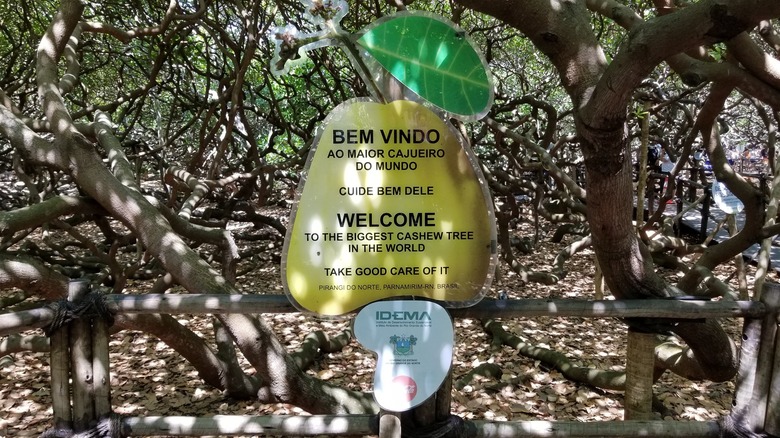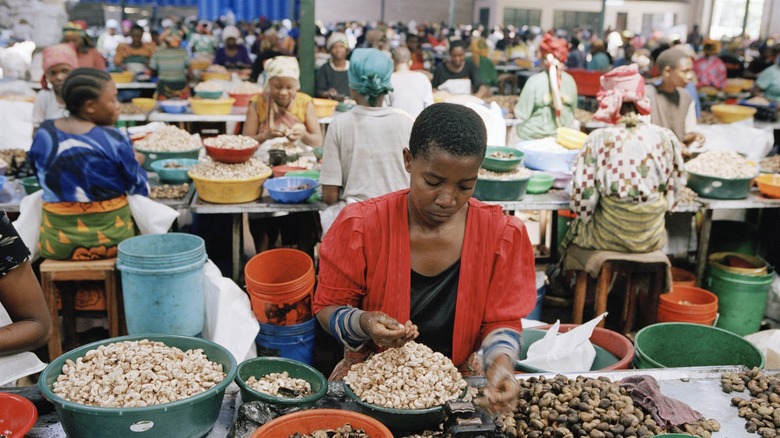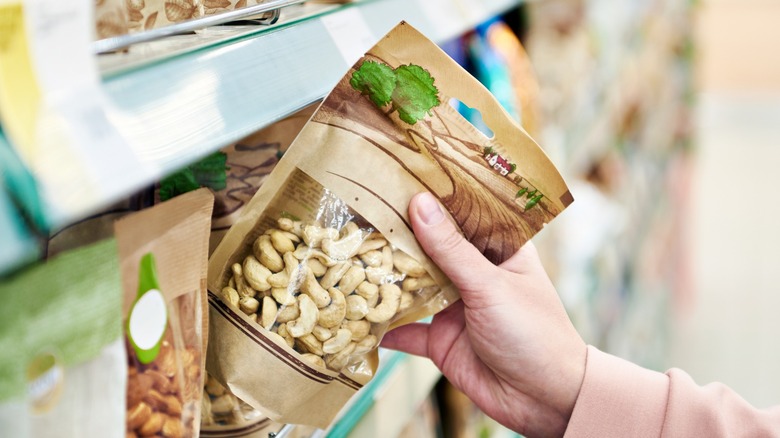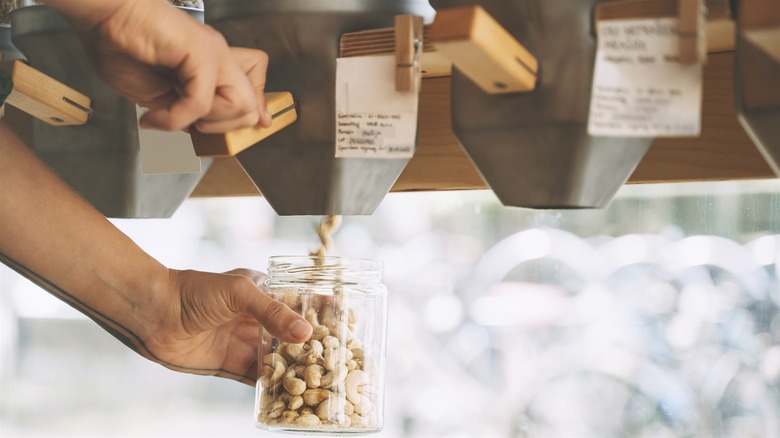13 Facts You Need To Know About Cashews
They're curvy, they're buttery, they're healthy — the allure of cashews seems to only be growing the more you learn about them. But these sweet, nutty morsels are far more complex than their unassuming appearance suggests, and many of us would benefit from learning more about where they came from and what influenced their rise to popularity. Packed with heart-healthy fats, protein, and essential minerals, cashews offer a nutritional powerhouse in a small package. Their unique texture and mild flavor have made them a darling of the culinary world, particularly among vegans and lactose-intolerant individuals seeking dairy alternatives. From luscious cheeses to velvety cream, these versatile nuts have quickly taken over the plant-based movement.
However, the cashew's journey from tree to table is fraught with ethical and environmental concerns, from its roots in colonial history to the cashew industry's ongoing associations with worker exploitation and high carbon emissions. Explore this complicated dichotomy and learn everything you need to know about cashews here.
The cashew is a seed of a false fruit
If you're reading this, you must be familiar with the sweet taste and soft bite of cashew nuts and craving to learn more about them. What better place to start than their natural origins? While they're often classified as tree nuts alongside almonds and walnuts, cashews are technically not nuts. While they do grow on shrubs, botanically, cashews are actually seeds. In a fascinating growing process, the tree first develops the kidney-shaped drupe bearing the seed we know as the cashew nut. Surprisingly, the drupe is the true fruit of the cashew tree, whereas the cashew apple that eventually grows from the stem supporting the drupe is considered a false fruit.
These fruits used to be discarded in favor of the highly prized drupe seeds, but now they're known for their high vitamin C content and antioxidant activity. Unfortunately, cashew apples don't travel well, so unless you live in a cashew-producing region, you are unlikely to try it. However, if you visit Brazil, Vietnam, or India, you'll see them turned into juice and various fermented drinks, preserved as a jam, or eaten in chutneys. They are mildly sweet and nutty (though high in tannins), with a texture like a non-juicy apple — an acquired taste worth trying out.
Raw unshelled cashews are toxic
Contrary to popular belief, the "raw" cashews available in stores are not truly raw — they must undergo quite a few processing steps before they're ready to eat. Freshly picked cashews are laden with urushiol, a toxin also found in poison ivy, mango, sumac, and other relatives within the Anacardiaceae family. This substance resides in the oil between the cashew nut and its outer shell, and getting exposed to it can result in allergic contact dermatitis, causing itchy, inflamed skin rashes. Moreover, the shell contains formaldehyde and anacardic acid, both dangerous for human skin. But that's the risk consumers rarely take, unlike the workers or processing plants.
Here is how manufacturers make cashews safe for consumption. The most crucial step involves heat treatment, which starts with sun-drying the fruit. Next, they apply direct heat or steam, which facilitates the removal of the toxic outer shell, and the kernels are roasted to remove the inner shells. Finally, the nuts go through shelling and peeling stages before being distributed. Talk about high-maintenance snacks! So, when you encounter "raw" cashews at the store, know that, in this context, it means they simply have no add-ons such as salt or flavoring.
Cashews are a versatile ingredient
If you're used to treating cashews as a mere snack, consider taking your relationship to the next culinary level. There are plenty of creative ways to use cashews in the kitchen. They're creamy, buttery, and mildly sweet, which makes them perfect for desserts and smoothies, yet they can also add a satisfying bite to a fish crust or protein balls. Cashews can help you skip dairy when making creamy soup — their high fat content will create a velvety texture after blending. In fact, pretty much any recipe can be turned dairy-free with cashews. While they are expensive, their price point is no match to that of pine nuts, which makes them an affordable substitute for sun-dried tomato pesto.
For more cashew inspiration, look to the cuisines of the world. Native to South America, this prized nut has spread around the world with Portuguese colonizers and has become enmeshed in Indian, Chinese, Thai, Vietnamese, and other cuisines. You can make vegan cashew chicken with tofu or crush the sweet nuts over curries and tagines. If you're bored with cashew cheesecakes, explore cashew sweets from other cuisines. For example, try kaju katli (also known as kaju barfi), a traditional Indian treat made with ground cashews, milk, and rose water.
They might need extra prep for cooking
Whether you're making your own cashew milk or a dairy-free cheesecake, infusing the nuts with liquid first is key. You can do this by soaking them in cold water overnight (though preferably not more than 12 hours, or they'll get slimy), letting them sit for a couple of hours in hot water, or simply boiling them for 15-20 minutes. From a nutritional standpoint, doing so allows cashews to drop those anti-nutrients and become more digestible. But the main reason soaking cashews is so highly recommended is more practical: It makes them softer and more blendable, ensuring a velvety, lump-free texture for your sauces, drinks, and desserts.
Another thing you can do to improve cashew texture is roast them. But if you want them to be crunchy and flavorful, paradoxically, you'll still need to start with a soak. Only this time the liquid doesn't have to be plain water; you can use a brine filled with spices of your choice, and let those flavors seep into the nuts. After a couple of hours in the brine, drain and pat-dry them — these steps will amplify their flavor. Next, toss them with salt, spices, or syrup, and roast at 350 degrees Fahrenheit, stirring occasionally, for 10 to 15 minutes. They'll make a wonderful snack or topping!
Cashews are a nutritional powerhouse
Who doesn't love a snack that isn't just delicious, but also good for you? First off, these nuts are packing some serious protein: A handful of cashews will give you a decent chunk of your daily needs. But that's just the opening act. Cashews also contain a good amount of magnesium, zinc, phosphorus, and iron, as well as vitamins B6 and K, which makes them an excellent addition to a plant-based diet.
And let's not forget about those heart-healthy fats — you know, the ones that tell "bad" cholesterol to take a hike. Cashews are rich in poly- and monounsaturated fats, which play a crucial role in boosting heart health and reducing cholesterol levels when consumed in moderation. More importantly, cashews are not the saturated fat villains they were once thought to be. While it's true that cashews contain about 20% of it, it's mostly stearic acid, which doesn't seem to have negative effects on cholesterol. On the contrary, participants of a 2017 study by The American Journal of Clinical Nutrition lowered their harmful LDL cholesterol levels by roughly 5% after adding 1-2 ounces of cashews to their daily rations. So, despite their high calorie content, it seems you can snack on cashews to your heart's desire.
They're an excellent dairy substitute
In plant-based kitchens, cashew is king. In fact, Research and Markets reports that the increasing popularity of plant-based eating is the driving force behind the cashew market expansion. This shift is understandable, as cashews have such a broad culinary potential for vegan dishes. Fancy a creamy vegan pasta sauce? Or some cheesy dairy-free nachos? Cashews are here for you. Soaked and blended, they can be transformed into anything from milk and cream to cheese and sour cream to rival traditional dairy-based products. Cashew milk makes a more full-bodied alternative to dairy than soy or almond varieties. It's also one of the easiest nut milks to make — no straining required! In terms of flavor, cashew cream is more versatile than its coconut counterpart, as its taste is more neutral.
Once you've done the prep, there's seemingly no limit to what you can use your cashews for. Vegan mac and cheese, made with a cashew-based cheese sauce, offers a plant-based version of this comfort food classic. Homemade vegan bechamel sauce and Caesar salad dressing are both made infinitely better by using cashews. And, of course, it's a perfect base for vegan cheesecake and ice cream.
You don't have to go homemade, either. Miyoko's Creamery, Forager Project, and Elmhurst are among many brands offering cashew-based products.
Some people should consume cashews with caution
While cashews are often lauded for their nutritional benefits, not everyone can reap them. Some people should steer clear of these nuts to avoid significant health risks. First off, let's talk oxalates. Cashews contain a notable amount — 49 milligrams per ounce — which, while not as high as some other nuts, for some poor cashew-loving souls, it can become a one-way ticket to Kidney Stone City. For individuals prone to such issues, moderation is key. Moreover, oxalates can interfere with mineral absorption, and in rare cases, excessive consumption may even lead to oxalate nephropathy, per a 2023 Military Medicine article.
But that's not all. For the unlucky few, cashews can turn into a full-blown nightmare. Cashew allergies, while not the most common among tree nut allergies, affect approximately 20% of tree nut allergy sufferers in the U.S. These allergic reactions can be particularly severe and persistent. Among children, they sometimes go hand-in-hand with early-onset atopic dermatitis and multiple food allergies, according to a 2021 Turkish Archives of Pediatrics study. It's like winning the lottery, except the prize is a lifetime of EpiPens and dermatologist visits.
So, before you go nuts (pun intended) on cashews, think twice. Don't let their curvy charm fool you if you suspect you might be sensitive to the things they bring to the table.
The history of cashews is rooted in colonialism
As much as cashews deserve our praise for their health benefits and culinary potential, it's time to dive into the dark side of that innocent-looking curved nut. Hailing from Brazil, the nut was used by indigenous Tupi people for centuries — even its modern Portuguese name caju comes from the Tupian word for "nut": acajú. But in the 16th century, cashews got caught up in the Portuguese empire's grand scheme of agricultural domination. As colonizers discovered the medicinal properties and wine-making potential of cashew fruits, they shipped it off to India and Africa faster than you can say "mercantilism."
The resilient cashew thrived in its new South Asian and African homes. By the 17th century, it had spread across Portuguese colonies like wildfire. But if you think that its colonial roots are far behind us, think again: Mozambique was a Portuguese colony until 1975, and just 10 years prior, it was one of the world's leading cashew producers, accounting for approximately half of global production. But let's not sugarcoat it — this cashew empire was built on the backs of forced labor and misery. Post-independence, the Mozambican cashew sector faced numerous challenges, reaching its nadir in 1982.
Most of the world's cashews don't come from their native Brazil
The global cashew industry wouldn't exist if it wasn't for colonialism. Yet it created a year-round cashew availability, because the countries doing big numbers in cashew production on both sides of the equator have complementary harvesting seasons. But that also means that most cashews don't come from their native land.
Ivory Coast has emerged as the leading producer in recent years, with 970,000 metric tons exported in 2022. Notably, 70% of global production is concentrated in the top seven producing countries, including India, Vietnam, Philippines, Tanzania, Benin, and Indonesia. While African nations dominate production, processing is primarily conducted in India and Vietnam. You might be surprised to learn that, despite the cultural and economic significance of cashews in Brazil, its more modest contribution to the global market currently ranks at number eight.
India also stands out not only as the world's largest consumer of cashews, with an annual consumption exceeding 300,000 metric tons. Europe, particularly the Netherlands, Germany, and Italy, represents the largest import market, making up 40% of 2022's global cashew import value, whereas the U.S. had only a 28.5% share. Interestingly, 85% of cashews imported to the EU and UK originate from processing countries rather than producing ones.
Cashews are a culturally important crop in Brazil
When you think of Brazilian cuisine, cashews probably aren't the first thing that comes to mind. Yet, Brazil is the home of not only the largest cashew tree in the world, but the root of the world cashew industry. There, cashew is the understated cultural icon and the economic backbone of the country's northeastern region. The industry supports approximately 170,000 producers across 53,000 properties, with the majority being small-scale farmers. This sector generates around 250,000 jobs.
The cashew's native land takes full advantage of the plant's edible parts: the caju (cashew apple) and the castanha de caju (cashew nut), with the former being the real star of this show. This false fruit, with its drupe dangling like some botanical afterthought, is the poster child of Brazil's northeast. It's plastered on everything from beach towels to ad posters. Heck, even Brazilian President Luiz Inácio Lula da Silva has used it to flex his northeastern cred.
Furthermore, the cashew has permeated Brazilian popular culture. Notable examples include its representation in paintings by Beatriz Milhaze and Jean-Baptiste Debret, and its recent prominence in Rio Carnival's most popular samba song of 2024. Imagine a cashew history lesson that comes in the form of a funky samba — that's what "Pede Caju Que Dou... Pé de Caju Que Dá!" is.
The modern-day cashew industry is problematic
It's one thing to talk about the colonial crimes of the past, and another to face the reality of the modern-day cashew industry. Every step of the nut's route from tree to market is harmful, unsustainable, or problematic in some other way.
Per The Guardian, rapidly increasing Western demand for cashews at a reasonable price turns an already difficult, dangerous manual labor into a dehumanizing experience. ImPACT International further reports that underpaid (or even unpaid) workers face the toxic fruit without adequate protection. Traditionally, shelling is done manually, almost exclusively by women, many of whom aren't given or cannot afford protective gloves. While this technically allows for greater precision and reduces the likelihood of splitting the valuable whole kernel, this method ultimately exposes workers to the cashew husk's caustic chemicals, which can cause serious skin damage.
Given that cashews often cross continents from farm to processing factory, this global journey leaves quite a carbon trail. Plus, it creates an uneven split of the cashew industry's profits across different countries, with leading producers in West Africa missing out on economic opportunities due to a lack of processing facilities. So, if you care about workers' and women's rights, sustainability, and transparency, opt for Fair Trade-certified cashews when you can.
These nuts are expensive for a reason
Anyone who's ever fallen in love with the kidney-shaped nut has asked themselves at some point: "Why are cashews so darn expensive?" But as soon as you look closer at how the industry works, things become much clearer. It starts with the climate: Cashews come from a tropical fruit, which severely limits their growing area. Although cashews are available year-round thanks to staggered harvests, each cashew fruit takes a few months to bring its prized seed into edible condition, further complicating matters. Additionally, top growers, producers, and consumers are often on three different continents, and all that travel adds up.
Next comes the labor-intensive harvesting: Farmers hand-pick fallen fruits to remove the single raw cashew attached to each cashew apple (which is often discarded, creating unnecessary food waste). This manual harvesting ensures that only ripe cashews are collected, maintaining the quality of the harvest. Unlike other tree nuts, cashews cannot be sold in their shells due to their toxicity. This creates an added layer of labor, which contributes to the cost of cashews at the expense of workers' health and safety, as mentioned. So, unless the industry finds ways to exclude manual processing and cut intercontinental cashew travel, the price of cashews will likely remain high.
Cashews aren't too environmentally friendly
As the climate crisis worsens, discussions about the sustainability of certain popular consumer items become the norm. Some vegans, in particular, have been slammed for choosing almond milk as their preferred dairy alternative, but cashews have yet to come under fire.
This is surprising, considering the soaring demand and resulting carbon footprint spike — a nearly 20% jump between 2010 and 2017. Almonds are widely regarded as a thirsty crop, but cashews aren't far behind. Their average water footprint was 14,218 cubic meters per ton between 1996 and 2005, compared to almonds' 16,095, per UNESCO-IHE Institute for Water Education. The key difference between these nuts is in the water sources: Tropical cashews get most of their needs covered by rainwater. Plus, they're still more sustainable than actual dairy (particularly when taking greenhouse emissions into account). Once the golden child of soil erosion prevention, these little kidney-shaped kernels are now essentially the playground bully of monocultures, sucking the life out of the soil of the Ivory Coast. With climate change intensifying, farmers can't help but reach for chemicals to keep their precious nuts alive.
Fortunately, it's not all doom and gloom. Cashew trees are carbon-sucking machines, which partially offsets their globetrotting carbon footprint. Plus, use of their by-products increases their sustainability rating. So, are cashews eco-saints? Definitely not. But they're not wholly environmental fiends either.
